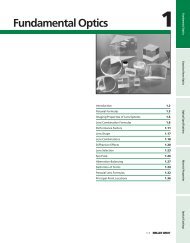g-factor of a bound electron
g-factor of a bound electron
g-factor of a bound electron
Create successful ePaper yourself
Turn your PDF publications into a flip-book with our unique Google optimized e-Paper software.
Theory <strong>of</strong> the free <strong>electron</strong><br />
QED contributions<br />
Self-energy and polarisation<br />
In addition to Dirac’s theory,<br />
there are QED effects which<br />
change the energy <strong>of</strong> the ground<br />
state<br />
(a) self-energy<br />
(b) vacuum polarisation<br />
This affects the anomalous moment <strong>of</strong> the <strong>electron</strong><br />
g e /2 = 1 + C 2 (α/π) + C 4 (α/π) 2 + C 6 (α/π) 3 + C 8 (α/π) 4 + ...<br />
First order Schwinger term C 2 = 1/2<br />
Ion Stroescu (Uni Heidelberg) g-<strong>factor</strong> <strong>of</strong> a <strong>bound</strong> <strong>electron</strong> January 11, 2008 14 / 32
















